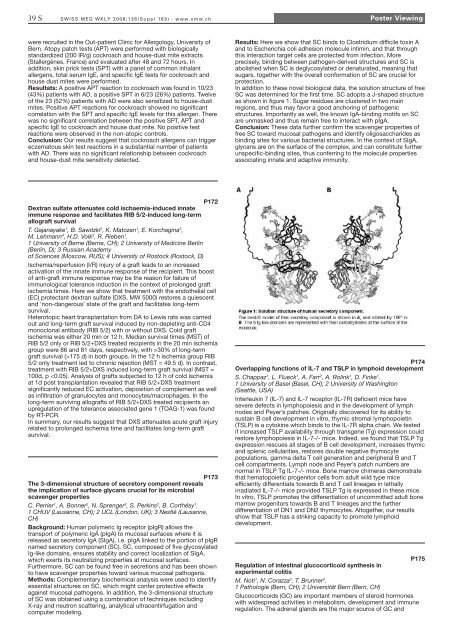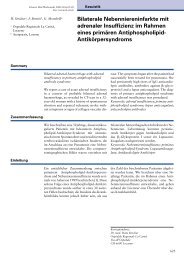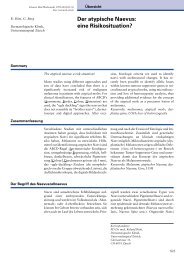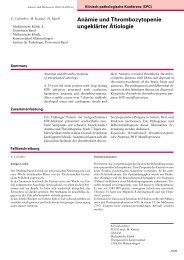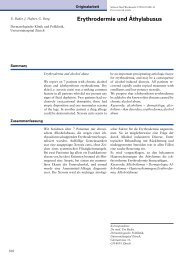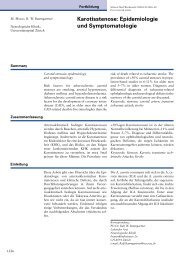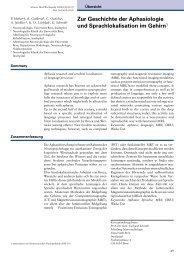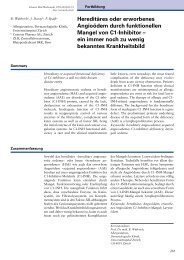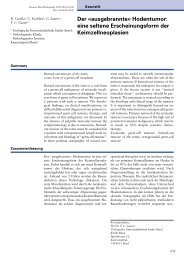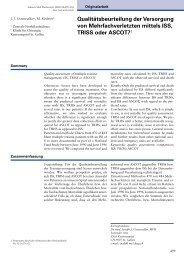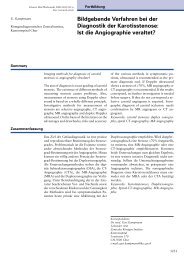Supplementum 163 - Swiss Medical Weekly
Supplementum 163 - Swiss Medical Weekly
Supplementum 163 - Swiss Medical Weekly
Create successful ePaper yourself
Turn your PDF publications into a flip-book with our unique Google optimized e-Paper software.
39 S SWISS MED WKLY 2008;138(Suppl <strong>163</strong>) · www.smw.ch<br />
Poster Viewing<br />
were recruited in the Out-patient Clinic for Allergology, University of<br />
Bern. Atopy patch tests (APT) were performed with biologically<br />
standardized (200 IR/g) cockroach and house-dust mite extracts<br />
(Stallergènes, France) and evaluated after 48 and 72 hours. In<br />
addition, skin prick tests (SPT) with a panel of common inhalant<br />
allergens, total serum IgE, and specific IgE tests for cockroach and<br />
house dust mites were performed.<br />
Resultats: A positive APT reaction to cockroach was found in 10/23<br />
(43%) patients with AD, a positive SPT in 6/23 (26%) patients. Twelve<br />
of the 23 (52%) patients with AD were also sensitized to house-dust<br />
mites. Positive APT reactions for cockroach showed no significant<br />
correlation with the SPT and specific IgE levels for this allergen. There<br />
was no significant correlation between the positive SPT, APT and<br />
specific IgE to cockroach and house dust mite. No positive test<br />
reactions were observed in the non-atopic controls.<br />
Conclusion: Our results suggest that cockroach allergens can trigger<br />
eczematous skin test reactions in a substantial number of patients<br />
with AD. There was no significant relationship between cockroach<br />
and house-dust mite sensitivity detected.<br />
P172<br />
Dextran sulfate attenuates cold ischaemia-induced innate<br />
immune response and facilitates RIB 5/2-induced long-term<br />
allograft survival<br />
T. Gajanayake1 , B. Sawitzki2 , K. Matozan1 , E. Korchagina3 ,<br />
M. Lehmann4 , H.D. Volk2 , R. Rieben1 .<br />
1 University of Berne (Berne, CH); 2 University of Medicine Berlin<br />
(Berlin, D); 3 Russian Academy<br />
of Sciences (Moscow, RUS); 4 University of Rostock (Rostock, D)<br />
Ischemia/reperfusion (I/R) injury of a graft leads to an increased<br />
activation of the innate immune response of the recipient. This boost<br />
of anti-graft immune response may be the reason for failure of<br />
immunological tolerance induction in the context of prolonged graft<br />
ischemia times. Here we show that treatment with the endothelial cell<br />
(EC) protectant dextran sulfate (DXS, MW 5000) restores a quiescent<br />
and ‘non-dangerous’ state of the graft and facilitates long-term<br />
survival.<br />
Heterotopic heart transplantation from DA to Lewis rats was carried<br />
out and long-term graft survival induced by non-depleting anti-CD4<br />
monoclonal antibody (RIB 5/2) with or without DXS. Cold graft<br />
ischemia was either 20 min or 12 h. Median survival times (MST) of<br />
RIB 5/2 only or RIB 5/2+DXS treated recipients in the 20 min ischemia<br />
group were 86 and 81 days, respectively, with >30% of long-term<br />
graft survival (>175 d) in both groups. In the 12 h ischemia group RIB<br />
5/2 only treatment led to chronic rejection (MST = 49.5 d). In contrast,<br />
treatment with RIB 5/2+DXS induced long-term graft survival (MST =<br />
100d, p


